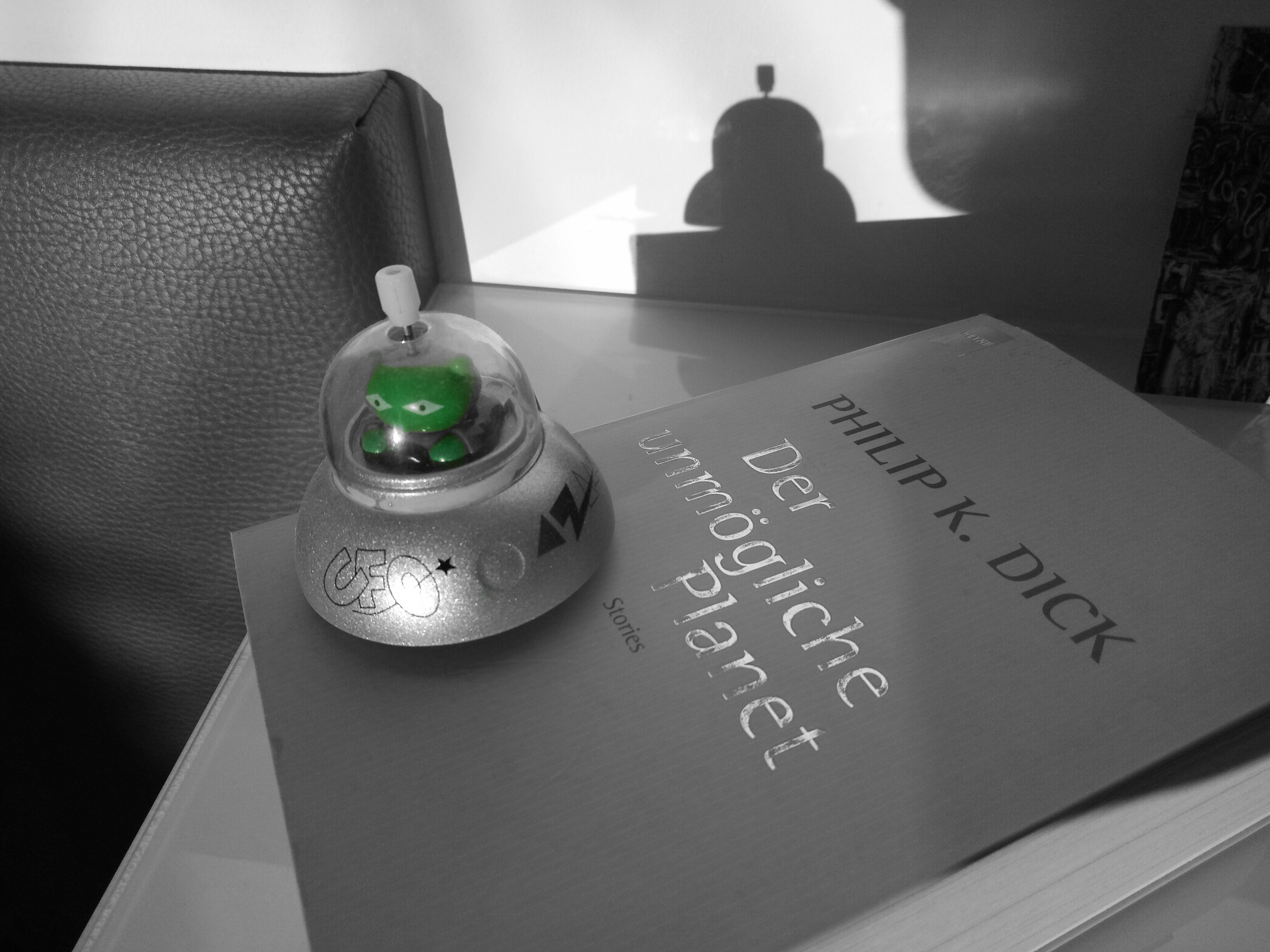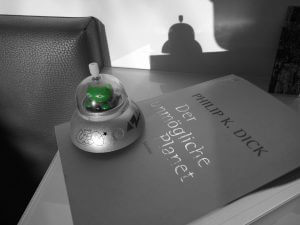Old editions of futuristic literature were also called “utopian-technological fiction” in German. Phantastic literature has travel from the island of utopia into space an back to earth, fascinating then as it does now.
Dystopia is the new utopia.
ist von der Insel Utopia in den Weltraum und wieder zurück auf die Erde gereist und fasziniert damals wie heute.
Dystopie ist die neue Utopie. Whether it’s young adult fiction, science fiction or near fiction, dark worlds or built and described, causing fascination and fear. Despite all the social criticism it contains, it remains entertainment that leaves you feeling happy about reality afterwards, as it is not as bad as this bleak vision of the future.
Current examples are the popular cinematic films The Tributes of Panem, In Time, oder the recently adapted young adult book series The Divergent. If you take time for reding, you can find many more interesting young, adult, and all-age books on those topics.
Drone State (Drohnenland) by Tom Hillenbrandt is a near-future-criminal thriller with critical humor about modern technology and recent political developments in Europe, threatened by cyber crime, climate change, bureaucracy, and greed for money. The Austrian author Ursula Poznanski captivates readers with intelligent crime novels and young adult books like Layers, Erebos and the dystopian science-fiction-trilogy Eleria / Contrived. The the widely travelled author of young adult books, Teri Terry, goes in a similar direction in her trilogy telling a not-so-unrealistic future for the United Kingdom.
The Circle by Dave Eggers is a satire on the possessive power of sharing economy and its striving for a digital utopia which is becoming increasingly totalitarian.
Among the oldest science-ficiton classics, which have hardly lost any of their relevance, is the surrealistic novel Solaris by Polish author Stanislaw Lem that was adapted cinematically mutliple times.
Solaris: Standislaw Lem, Andrej Tarkowskij and Steven Spielberg:
Stanislaw Lem (1921-2006): Solaris – The new edition of Solaris by autor and satirist Stanislaw Lem starts with a foreword by Ursula K. Le Guin ( The Left Hand of Darkness, 1969), who declined the Nebula award out of soldiarity with Lem 1973 after his honorary membership of the Science Fiction Writers of America had been revoked. Solaris has not been released in the USA before 1970, nine years after its original release in Poland. Solaris is a strange story about people inhabiting a space stations that orbits around a planet with a vast ocean that seems to possess a consciousness that is not really accessible to human scientists. The space odyssey becomes a travel into the people’s past … although a friend of mine loved the new Spielberg adaption with George Clooney, I’d rather recommend you watch Tarkowski’s Russian film of the 1970s. Although quite lenghty, it perfectly conveys the weird atmosphere and its subtle humor. Of course you should still read the book as well! Stanislaw Lem was a doctor, a car mechanic, an intellectual, and author of numerous phantastic novels. He was always critical of today’s obsession with technology. In March 2006, he died in Kraków after a long illness.
Classics of Science-Fiction Literature
Philip K. Dick (1928-1982) has written various phantastic stories in his lifetime, some exciting, some thoughtful, and the German publisher Heyne compiles an anthology of his stores as part of their recent series of SF-rereleases: The Impossible Planet (Der unmögliche Planet) includes Total Recall (original title: We Can Remember It For You Wholesale, 1966) and Minority Report, both became popular for their cinematic adaptions.
John Brunner is also rightly considered a classic of science-fiction literature. His topics cyberspace (The Shockwave Rider), ecological disaster (The Sheep Look Up) and the epic Crucible of Time still fascinate more than twenty years after they were written.
The German title, “Brain War” for Jack Vance’s Nopalgarth is a typical example of the silly translation failures of that era, but it’s a nice short science-fiction story about an apparently or actually freed mind. Bastei Lübbe, another German publisher dedicated to science-fiction, re-released it as a double feature together with “War Languages”, originally called The Languages of Pao, less convincing, but still worth reading. Both books are nearly fifty years old now.
David Brin: The Practice Effect and Earth (1990).
David Brin is rightly repected and awarded both as a scientist and as a science-fiction author. He is able to tell an extremely unlikely story in the most convincing way, and despite dramatic and threatening moments, it is true that his optimism always shines through. Sundiver (1980, only released in German in 1995) is sometimes confusing, sometimes funny, and always full of surprising twists like a thriller.
Dune (1965) by Frank Herbert is one of the best-known works of science-fiction and it has been adapted as films and series multiple times, including several spin-offs (that I didn’t read or watch and that I’ve been advised against). The inhabitants of the desert planet, Arrakis, have a lot in common with the Touareg and it often feels like a documentary about a religious brotherhood who have retreated into the desert. While those gigantic sandworms haven’t been sighted on planet earth so far, aristocratic and political intrigues aren’t unknown to our planet. The story has something historic, maybe even a bit like a fairy tale. Always prefer to read the original, not the unconventional German translation which I found confusing and hard to understand.
Rebels in Cyberspace: Piercy, Noon, and Stephenson:
Marge Piercy: He, She, and It
This out-of-the-ordinary book is more thatn “an astonishing combination of cyberpunk and Jewish culture” (Wolfgang Tress), and it’s a book that found its fans beyond the tech-loving science fiction scene. Garnished with flash backs to the historic Prague where the old legend of Golem comes alive, this is a versatile reading pleasure. Piercy
sondern vor allem ein Buch das seine Fans auch außerhalb der technikverliebten SciFi-Szene gefunden hat. Garniert durch Rückblicke ins historische Prag, wo die alte Legende des Golem lebendig wird, ist dieser Roman ein sehr vielseitiges Lesevergnügen. Piercy succeeds in reviving a small utopia within a grotesque, gloomy vision of the future.
Jeff Noon has written some quite bizarre books. His version of cyberspace is closer to Beatnik literaure than to science-fiction. The human and diverse other protagonists suck on special feathers to enter the Vurt, that strives to influence the (not) normal real world. The story is set in a future Manchester whose surreal inhabitants (including dog-people and half-dead) are a parody on the real 20th century world for sure. The first volume, Vurt (1993), has the nondescript German title Gelb (Yellow), the sequel is called Pollen (1995).
Neal Stephenson: Snow Crash (1993)
Stephenson’s visio of cyberspace as a three-dimensional internet, has inspired many a programmer; contemporary readers will probably more enjoy the witty allusions to religions and cults since Babylonian times and the fast, colloquial tone telling this wild story that was originally planned to become a graphic novel. The protagonists, Hiro Protagonist (as the name suggests) and Y.T., a young courier rider on a hovering skateboard fight a worldwide conspiracy using religion, digital and biological viruses as their tools. Snow Crash is one of those stories, which, under the guise of science fiction, reveal a great deal about our present.










openmindculture
Note that I finally managed to translate and update one of my oldest blog posts, adding the classic Winds of Altair and replacing real cover images with my own artwork.